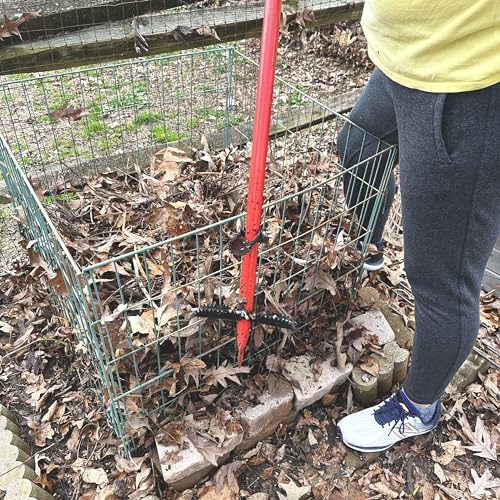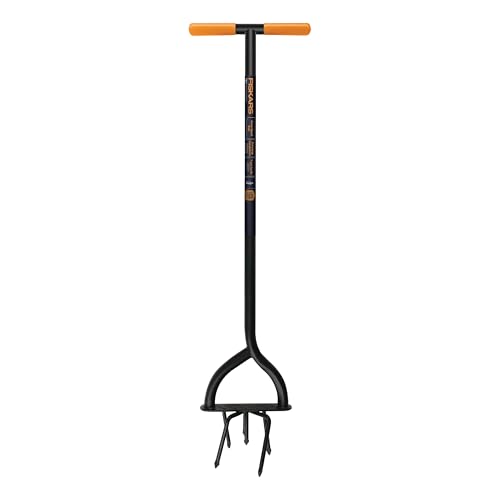Last Updated on June 19, 2021 by Grow with Bovees
Compost aerators, sometimes called compost turners are simple garden tools that help speed the decomposition of compost by mixing it.
Composting is a great way to recycle your yard waste and kitchen scraps, but it takes time.
If you turn the compost periodically, you’ll speed the decomposition process and get the finished compost sooner.
Aerating your compost offers myriad different benefits, most notably accelerating decomposition in your compost pile. Aerating aka turning your compost pile makes a world of a difference in making compost within 4 – 8 weeks rather than 6 – 8 months, and here’s why!
Every pile of compost needs a periodic influx of oxygen to activate the bacteria. If the bacteria feel sluggish due to a reduced oxygen supply, your compost heap may decompose slower, at lower temperatures, and possibly emit odor.
There are several ways to turn a compost pile including manual turning with a pitchfork or shovel, or easily with a compost tumbler, bin and a compost aerator.
When deciding between a compost tumbler or compost bin, bins have a larger capacity so you can turn more compost, whereas compost tumblers feature a smaller capacity, so you can’t spin larger loads.
Buying the best compost aerator however can be a bit overwhelming, given the many models available. But we’ve diligently researched this segment, and narrowed down on 5 best compost aerators that will help you turn your compost pile easily and efficiently.
5 Best Compost Aerators / Compost Turners
1. Lotech Products Compost Crank Compost Aerator
Slotting in at the #1 position on this list of best compost aerators is the Lotech compost mixing tool and for several reasons. For starters, this aerator is handcrafted in Tucson, Arizona, USA, and from recycled parts.
Stainless steel for corrosion resistance
Reliable compost aeration
It is a solid 3/8-inch stainless steel construction and topped with comfortable, free-spinning glass-filled nylon handles, complete with stainless washers. Further, the Lotech aerator measures 42-inches in height, and boasts a 29-inches effective depth, making is fairly easy to twist through vines and other harsh compostable material.
Adding to this, it is easy to use by first cranking clockwise into the compost, and lifting without turning, which allows the integrated corkscrew to easily aerate any compost bin.
Speaking of which, the Lotech Products compost crank aerator measures 45 x 1 x 4 inches, and tips the scales at just 2 lbs, making it a joy to use even when aerating large bins of compost. It is backed by a lifetime limited warranty against any manufacturer defects.
Pros:
- Handcrafted in Tucson, Arizona, USA with recycled parts
- Made from solid 3/8-inch stainless
- 45” height and 29” effective depth
- Comfortable handle with stainless washers
- Lifetime limited warranty
Cons:
- May be hard to pull out beyond 36-inches deep
2. Bosmere Compost Aerator
The Bosmere compost aerator is a great choice for anyone looking to activate their heap at any level and is crafted from rustproof metal. Adding to this, it is a joy to work with even across longer periods, thanks to its onsite vinyl hand grip. The handle of this tool is adjustable, so you can set the perfect height for your needs.
Adjust for left or right handed use
The Bosmere compost aerator weighs a little over 2 lbs, and measures a long 36-inches in height, making it easy to turn large piles of compost. Furthermore, this tool from Bosmere is equipped with two sets of activation wings, which collectively fold to dig deeper into the pile and open out to aerate.
Pros:
- 36” in height
- 2 activation wings for effective aeration
- Left and right-handed vinyl grip
- Made from rustproof iron
- Adjustable handle
Cons:
- Handle may become loose but can be screwed back easily
3. Yard Butler Twist Tiller
The Yard Butler Tiller is in a league of its own, owing to the superior performance it provides when turning compost piles. It stands 38-inches tall and is also fitted with a step plate, so you can plunge the tool deeper into the heap.
Can also be used for cultivation, tilling and weed pulling
Adding to this, the aerator features a solid ½-inch steel shaft, and a 12-inch steel handle, which collectively greatly reduce the effort of twisting, as you can easily rotate the sharp claw tines even in hard compost.
Apart from compost aeration, the Yard Butler aerator can also be used for preparing vegetable bed gardens, and to promote the free flow of water. It is backed by a 30-day satisfaction guarantee, so you can rest assured you’re buying the right tool for your needs.
Pros:
- 38” tall
- Fitted with step plate
- ½-inch steel shaft, and a 12-inch steel handle
- Simple to rotate, sharp claw tines
- Backed by 30-day money back guarantee
Cons:
- Cannot be used to remove moss from gardens
4. Fiskars 79906935J Compost Aerator
The Fiskars compost aerator is one of the top-selling products of one of the world’s largest lawn care tool companies and is fitted with six welded and hardened stainless steel tines.
These tines work collectively to quickly aerate the compost heap. The Fiskars aerator comes with a long 18-gauge steel shaft, which is designed to provide great durability for years to come.
To top things off, the Fiskars tool comes with an extra-large foot platform, which offers optimal force when driving the tines into the material. This top of the line tool is equipped with a 40-inch long, T-shaped handle, so you get top-notch control when working with it.
Pros:
- 19-gauge steel shaft
- 6 arrow tipped tines
- Extra-large foot platform
- 40” T-shaped handle
Cons:
- May not be a good choice for taller users
5. Yard Butler ICA-36 Compost Aerator
Another hit from the Yard Butler stable, the ICA-36 compost aerator is fitted with aeration wings, which automatically unfold and aerate as you pull the tool up through the compost heap.
It is made entirely from powder coated stainless steel and features a long 37-inch handle, so you won’t have to bend over to aerate the compost. It is lightweight at just three lbs, making it easier to work with, especially when aerating large piles.
Not as many uses as the other Yard Butler tool here
Pros:
- Made from powder-coated stainless
- 37-inch tall handle
- Cushioned grips
- Folding harpoon wings
Cons:
- Wings may not open up at times
Compost Aerators Buying Guide
When shopping for the best compost aerator, you’ve got several options to choose from, making it a bit challenging to get the right one for your needs. But here are a few things to consider ensuring you buy one that gets the job done right!
Types of Compost Aerator
There are several types of aerators available — corkscrew, plunger models and the crank compost aerator type.
If you’re mixing a small amount of compost, then you should be fine buying a corkscrew type aerator, whereas if you’re dealing with tough compost material, then a plunger-type aerator with spikes will help your composting process with relatively little effort.
Design and Size of Compost Aerators
Aerators can be ordered in a wide range of sizes, generally between 12-inches to 38-inches. If you don’t mind putting your back into the task, a smaller size aerator is best suited for you, but buy a taller model if you’re suffering from back issues or simply want to make the job as easy as possible.
Build Quality
Compost aerators can be made from either aluminum and stainless steel. While both materials are highly durable, you want to buy one that is rustproof or at the very least, treated to resist rust.
Comfort Padded Handles
Using a compost aerator, especially for long periods of time can take a toll on your hands. To prevent this strain, buy a compost aerator tool that’s fitted with padded grips on the handles.
Should You Aerate Your Compost Pile?
The big question when it comes to compost piles is to turn or not to turn? While cool piles of compost may not necessarily need turning, they could definitely benefit from periodical aeration to open some gaps in the oxygen-deprived spaces of the piles.
Hot piles of compost do need frequent aeration because their microorganisms suck up the oxygen in their open spaces fairly quickly. You should basically aerate any compost heap that has started producing ammonia or gone anaerobic.
Why Is Water Important for Compost Piles?
Water is an important nutrient in your composting process, as it helps keep the pile’s temperature regulated. Moisture levels need to be present in the right amounts because too much or too little water can actually hurt the pile, which in terms of numbers is 40 percent to 60 percent water.
Water is an essential nutrient for most if not all life including the microorganisms and insects that help decompose compost. If there’s too much water in your compost pile, these microorganisms won’t break down the compost as effectively.
Is There an Easier Way To Introduce Air Into Compost Besides Turning It?
There is no easy way per se of aerating compost, but you can run a perforated-pipe along the ground so that both ends stick out the outside of the pile. Then, run a second pipe vertically, and then build your compost pile around the vertical pipe, and over the bottom pipes. The goal of the pipes is to deliver air to the inner bulk of the pile.
How Often To Turn Compost
The guidelines to aerate a compost pile are pretty simple, where it is recommended that you turn small-batch piles of compost every few days for the first two weeks. You can tone the schedule down to once a week for the next four to eight weeks.
For add as you go piles, turn the pile every time new scraps are added. Take note that you should also check the moisture level of your compost pile periodically, and remoisten if necessary.
Where To Find the Best Finished Compost
The short answer is at the bottom of the bin, which the reason some compost bins have trap doors to easily remove the finished material, or else you can do it with a compost shovel. Pro tip: composted material is finished or ready for use when it’s dark, brown, and crumbly.
How To Use Compost Aerators
Before learning how to use a compost aerator, you should decide whether you’re going to turn the compost on its own or into two or three other bins, which takes a bit more effort.
But even though compost bins are used by millions of people, the downside to these bins is they’re taller, making it difficult for many to reach in and turn the material with a fork or shovel.
With an aerator, especially one that’s taller in height, you can easily turn the pile. To get started with a compost aerator, you first have to thrust it as deep as possible into the middle of the pile. Next, pull up the aerator while turning it to thoroughly mix the compost pile.
Final Thoughts on The Best Compost Aerator Tool
Aerating is probably one the best treatments you can give your compost piles, as it introduces oxygen, and helps it decompose quickly. There are several composting tools you can use to aerate your compost pile, like a compost turner, but an aerator works best, given the fact that you don’t really have to bend over into your compost bin to aerate.



